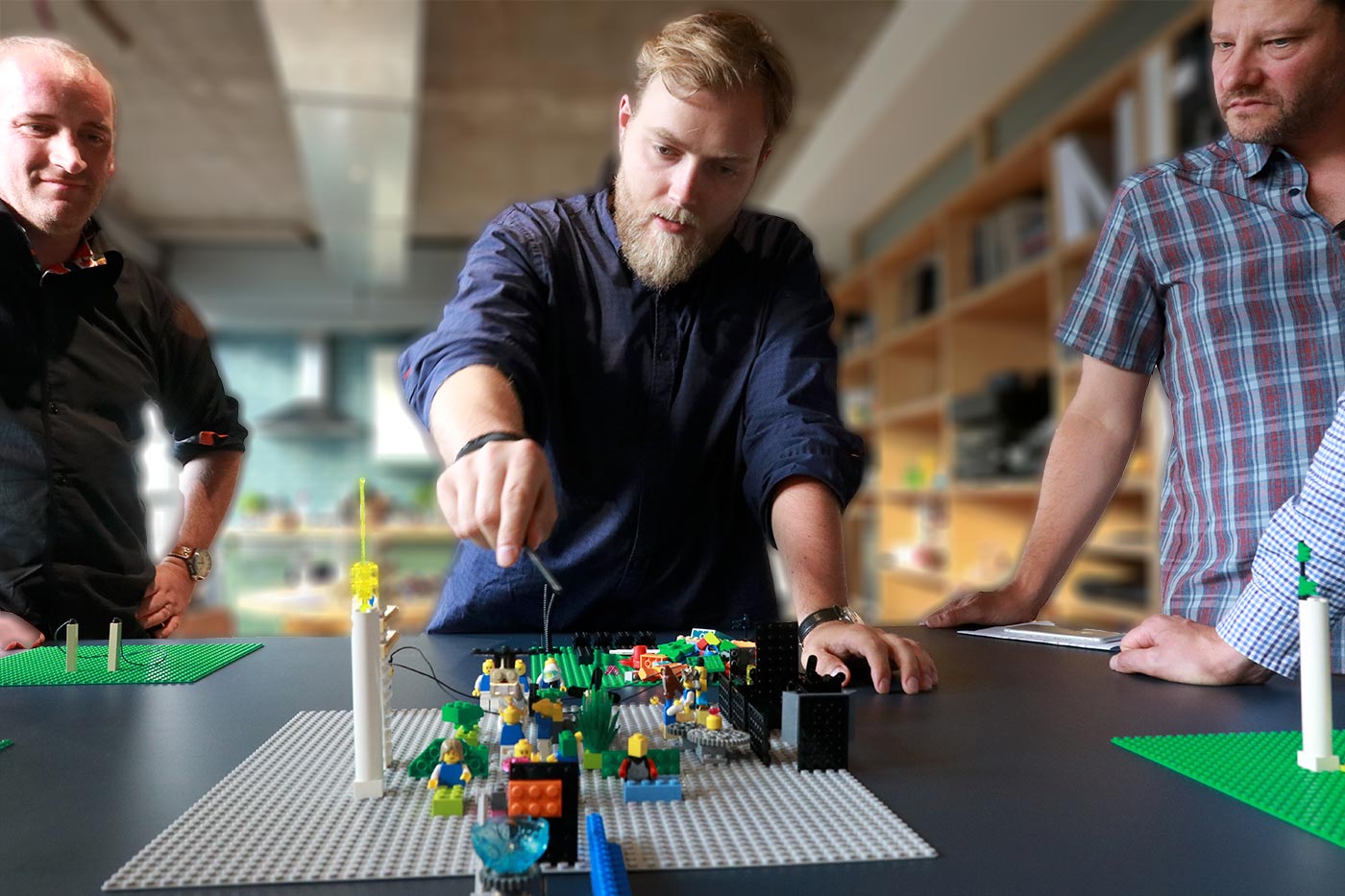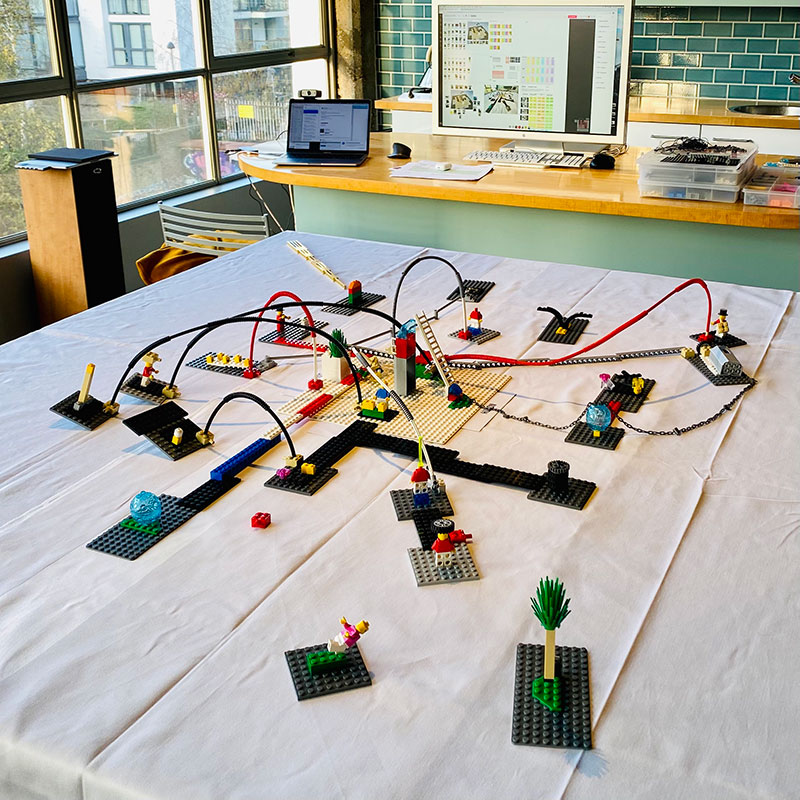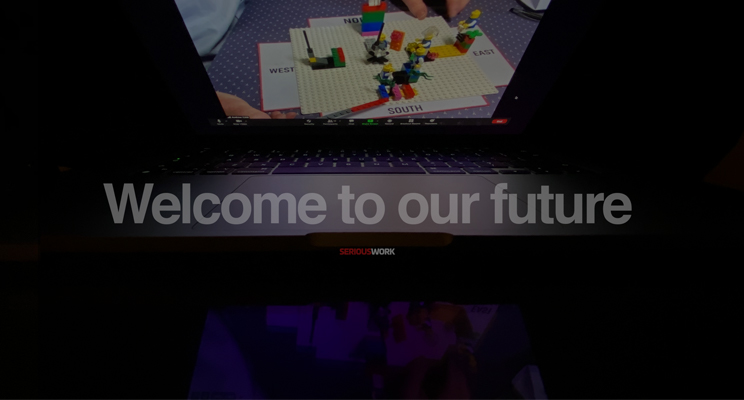



We love designing and testing ideas before we launch new techniques or trainings. The idea of prototyping is second nature to design trained SeriousWork founder Sean Blair.
In March 2021 we ran our second pilot of our online build level 3 – systems models class. Below you can read a detailed write up from LSPConnect co-founder Guy Stephens.

Some thoughts on Systems Build with SeriousWork, by Guy Stephens
In my opinion, over the last year there has only really been one player in the online space who has set out to share their journey of exploration into the world of online LEGO Serious Play with others.
And when I think about online LSP, I’m not thinking about it in terms of – let’s just do the same thing online as we would face-to-face. What I’m talking about is someone who has really considered what that online experience could be. Explored what the possibilities might be. Someone who has treated online in its own right, taking into account the characteristics, dynamics, idiosyncrasies and richness of the online experience from the different perspectives of the process, the facilitator and importantly the participant.
Whether LEGO Serious Play can be done online or not is a somewhat pointless question in my mind, a distraction. To those who decry the authenticity of online LSP, my response to you is very simple: Ok, Boomer, move on!
If a facilitator thinks it can be done online, then the challenge is to find a way for it to be done, whilst trying to remain as true as possible to the principles and philosophy of LSP. Only then, through trial and error can the question of online be answered. And through that trial and error, can the online experience become more and more effective.
And so over the last year, Sean Blair, Jens Droege and Helen Batt at SeriousWork have gone on that journey on our behalf. They have put in the long hours of research and pilots, and arrived at approaches that enable online LSP to come to life – individual models, shared models, ‘magic hands’ and now System Build.
I was fortunate enough to be invited to take part in one of SeriousWork’s early System Build pilots. A few days before the pilot, I received instructions about how many Exploration Bags I needed, the extra bricks I could bring in to play, and the different connections that would be needed. I also received a link to MURAL where a Systems Build canvas had already been created. I was also asked to prepare in advance a specific type of connection, and a short description of that connection; I’ll come back to this later.
Everyone has the same set of bricks
Let me be very clear: At no time did I feel as if my options during model building were limited. At no time did I find that the limited choice of bricks were a constraint on the stories that emerged. The stories did not lack for anything apart from bighlighting my inability to adequately tell the story of the model I built.
Whilst having the choice to use a Duplo elephant, ladder, skeleton or shark might enhance model-building, I am also a strong believer, that because any brick can represent any object, entity or concept, nothing is really lost in having a smaller selection of pieces. And if a participant has never done LSP before, then they are in effect, none the wiser.
As a further test of my imagination and creativity, unbeknownst to the facilitator and other participants, I challenged myself to only use one Window Exploration bag to build all the models required for the Systems Build. I would only allow myself to move onto the second Windows Exploration bag once I had finished using all the bricks from the first. As it was, I only ever used one bag.
Now, I am not saying that you shouldn’t or can’t have more bricks and connections, but what is important is that facilitators do not place any perceived limitations of creativity or process on these inanimate bricks. The onus lies with the facilitator not only to draw out that streak of creative output from each participant, but also with regards to the efficacy of the workshop experience in which LSP is the chosen approach.
One thing I am going to explore in future online workshops, is what difference it makes if participants have different bricks. For me, I’m not so sure it matters. At the end of the day, the bricks are a catalyst for the stories that they represent. As long as there are no impediments to a participant creating that story, then choice of bricks is a moot point.
I do take into account that if one adopts the ‘magic hands’ approach, having the same bricks makes complete sense. One could also equally propose that once a picture of the model, agent or shared model is done and now exists in the online space, then that is all that is required, as it is he story that now takes precedence.
Connections need to be nurtured
It became apparent to me by the time I reached the end of the Systems Build pilot that connections are somewhat overlooked, and spending a bit of time on them is well worth it.
Before the pilot began I received instructions on which connections I needed, as well as a short description of the nature of each of the connections we could use. I was also asked to build a specific connection type, and prepare a short description of it, which I would share with the other participants at the appropriate time in the pilot.
When I came to build my connection, I spent a bit of time considering the different characteristics of each of the connections I could use. I didn’t want to just join them in a cursory way, but really think about what was unique about each, how they differed, and how meaning could be attached to them in different ways to illustrate different types of connections.
When we got to the relevant part of the pilot, each of the participants shared their particular connection. It was a kind of connections ‘skill build’. What this did was to actually raise the level of understanding of what a connection was, some of the different ways in which the connections could be joined together, how they could be used, and also how we could actually talk about them. Suddenly a very rich narrative emerged.
What it meant was that by the time we actually started to connect the agents to the shared model, it was obvious that everyone was very considered and thoughtful in the type of connection they choose, where they wanted it connected, and the words they used to describe the relationship between the connected elements.
Interestingly, spending time on the connections, did nothing to stop that sense of surprise (and excitement) when it came time to actually understand the impact the connected agent had on the shared model, and the other agents around it. Pushing it, pulling it, still resulted in unexpected consequences.
The goal is the Systems Build
If you are doing a Systems Build, don’t lose sight of this. Try to get to the Systems Build part as quickly as possible. Not everyone will agree with me on this. But my thinking is this: once you get to the Systems Build and start to play it out with the different connections, you can, if needed, always update existing or old knowledge with the knowledge that has just been uncovered. Dwelling on the individual or shared model builds serves little purpose, as these are simply the catalyst to uncovering this new knowledge. I’m certainly not saying – Systems Model and be damned – just be sure not to over-index your time on getting there.
Agent ‘playtime’ in a virtual space
This was a revelation for me! Once the agents have been built they are then brought into a virtual space. Each agent is photographed and then the image uploaded to a platform such as MURAL.
The virtual space allows the participants to familiarise themselves with the agents and affords the opportunity for further discussion and sharing of insights to take place. What it also does is enable the participants to ‘play’ around with the placement of agents in relation to each other, as well as the shared model. It becomes obvious very quickly where physical gaps or conversely clustering of agents takes place, highlighting the possible importance of certain agents or parts of a shared model that may not be as relevant as had initially been thought. Once this ‘play’ has taken place, the facilitator can then move the agent to its final place in the physical model that is being built.
This was an unexpected moment for me, and one that I would definitely like to explore further in future online System Builds.
For those who have not used online collaboration tools like MURAL or Miro, I encourage you to try them out. One word of caution, however, is that these are great tools and lend themselves well to online LSP. However, a facilitator must be careful to ensure that they do not become a convenient replacement for thinking through carefully the flow and purpose of your workshop with due care.
Two baseplates are better than one
I remember when I first saw the set-up used by the facilitator that there were two baseplates in use. A slightly smaller one on top of a larger one. The larger one was dark grey, with the smaller one on top, a lighter grey. I couldn’t work out why the baseplates were set-up in this way.
All became apparent once the agents were connected to the shared model, and the impact of the agents was then explored. The shared model was built on the slightly smaller, light grey baseplate. What this meant was that when the agent was pulled or pushed, it moved smoothly, so that the full impact of any movement could be seen.
Small things matter
So in the final summary, can a Systems Build be done online effectively?
For me, the answer is yes. Without a doubt.
What is exciting is not whether it can be done effectively but rather, that we are at the outset of this journey of exploration. There is still so much to be explored in the online space, not as some kind of time-limited alternative, but as an option in its own right. It is facilitators like Sean Blair and Jens Droege, amongst others, who are proactively exploring on our behalf, sharing generously their findings so that we may all learn, and together, create different narratives and new assumptions, and in so doing add to the existing rich narrative of LEGO Serious Play.

As we say goodbye (and I’m sure for some of us ‘good riddance’!) to 2020, I thought I’d take a moment to share a few of our plans for the year ahead.
Education is a big focus for 2021
In the year ahead we will continue to bring LEGO® SERIOUS PLAY® to further and higher education, we plan to share more examples and frameworks showing how it is being used, especially during COVID-19, to improve the learners experience and learning outcomes, across a wide range of faculties including business, medical and engineering schools. #EducationInnovation. Expect us to announce out first sector specialist training associate in this area and the development of an education focused community of practice / knowledge exchange.
Systems and strategy
In the year ahead we will illuminate the problem of ‘silo-strategy’ (strategy created by a single entity in pursuit of singular aims) and illustrate the opportunities and benefits of systems thinking driven strategy. We think this work will offer leaders working at the higher strategic ‘Build-level 3: System Models’ a fundamental reframe on what LEGO® SERIOUS PLAY® is and does. We hope to show that this approach is timely and valid for the system level challenges organisations and society faces. From the research and development work undertaken so far, we think this will be our most important work to date.
New materials
We will be publishing a range of material showing LEGO® SERIOUS PLAY® in combination with other methods and techniques, for instance how LEGO® SERIOUS PLAY® works with growth mindset frameworks, positive psychology or to enhance learning with the scrum framework.
More translation of our books
Our three books will become available in more languages. ONLINE will be available in German, Spanish and Italian, MASTERING will be available in German, and our first book SERIOUSWORK will be published in Chinese/Mandarin Q2 2021 and with luck other languages to be announced!
We will bring LEGO® SERIOUS PLAY® to the attention of new audiences to show how the method is used to support organisational development, leadership development and organisational development. Maybe more HR professionals will consider LEGO® SERIOUS PLAY® a valuable tool amongst many other excellent HR tools and methods?
Advanced training
We are working on further advanced training options and advanced application development that we will teach in new advanced training classes, and we are developing a launchpad programme to help already trained facilitators, who have lost their mojo a route to rebuild confidence, sharpen skills and get into orbit!
In pursuit of gold standard
And of course we will continue to strive to offer the best LEGO® SERIOUS PLAY® training in the world. We will always deliver practice-based-learning to develop learners facilitation skills and confidence in applying the method in the environment our clients ask us to work in, online and face-to-face.
Thank you
Finally HUGE gratitude to all who have shared the journey with us this year, too numerous to mention, but you know who you are and I hope you can feel the warmth of my appreciation for the trust, creativity and fun you have bought to my year.
Happy New Year - Sean
Yay! #BookLaunchDay on the first day of #FacWeek.
So to get our week going we are sharing Martin Gilbraith (a CPF Master and International Association of Facilitators 'Hall of Fame' inductee) to provide the critical context on what a facilitator is and does.
He's also nice about our new book, ONLINE launched today.

I started out as a facilitator in 1986, with my first training in the ICA ‘Technology of Participation’ (ToP) methodology that has been my facilitation speciality ever since.
I have been providing facilitation and facilitation training professionally to a wide range of clients since 1997, became an CertifiedTM Professional Facilitator (CPF) of the International Association of Facilitators in 2008 and was inducted into the IAF Hall of Fame in 2014, then became CPF | Master this year in 2020.
All of this time I have worked remotely, in and with geographically distributed groups, as well as face-to-face. I have been using online technology in this work for as long as it has been available.
I have never sought to make online facilitation a particular speciality, however – until now, of course. I have not made LEGO® Serious Play® a speciality either, in spite of having enjoyed a long and distinguished early childhood career in LEGO®! I believe that a facilitator is first a facilitator, and only second an online facilitator or a LEGO Serious Play facilitator. I believe that the keys to mastering facilitation lie in the values and the stance of the facilitator, the competencies and the disciplines, rather than the space or the platform, the methods or the tools.
Nevertheless, I am excited to commend to you this book ‘How To Facilitate Meetings & Workshops Using The LEGO® Serious Play® Method Online’.
Here are three reasons why.
I know Sean, and that he is a competent, experienced and accomplished facilitator. Questions are the primary tool of every facilitator, and I know that he asks good questions and that he asks them well. In an early meetup of IAF England & Wales, in London in perhaps 2013, he posed the question:
“Is there such a thing as a universal principle of facilitation?”
It didn’t take me long to think and respond that, in my own facilitation at least, there is certainly something approaching that - the ‘ORID’ model underlies of the ToP Focused Conversation method and the ToP methodology as a whole.
I know that Sean has since integrated this approach in his practice, and in his previous book ‘Mastering The LEGO Serious Play Method’.
I was sufficiently inspired by the metaphor of ORID as a universal principle that I blogged about it then and have used it in my training ever since.
Many facilitators have rapidly developed a speciality in working online this year, as Sean and I have as well. Some have done so more quickly and easily than others, and some with greater enthusiasm. Most, in my experience, have had reservations about some of the very real limitations of online facilitation. Only recently I think more of us are becoming belatedly more aware of some equally real limitations of face-to-face, and some real advantages of working online.
So, it is not only LEGO Serious Play practitioners that might take heart and find inspiration in the many innovations that Sean shares in this book. There is much here for all of us to learn from - not least, the rigour and creativity with which he has designed ‘a digital process that uses bricks’ [substitute your preferred tool or method here] ‘rather than an analogue process poorly rendered online’.
I’ve heard it said that, in online facilitation, every participant brings their share of the meeting room with them. This is a challenge for LEGO Serious Play practitioners perhaps more than most, and one to which this book rises admirably.
As Sean makes clear in his Guiding Principles, success in achieving outcomes rather than just engagement through facilitation comes largely from the planning and preparation, and from the capacity to divert nimbly from the plan when the moment requires improvisation.
All of this can be considerably more complex and difficult online than face-to-face. So, if this is what can be done with LEGO Serious Play, think what else can be possible online!
Finally, we are in the midst of a climate emergency, as well as a public health emergency. I believe that the two are not unrelated, and that they demand new ways of connecting, communicating and collaborating that are less carbon intensive as well as more COVID-19 secure, and that are more creative, compassionate and empowering as well. I believe that facilitation has a central role to play on the latter, with bricks as well as without, and that designing and delivering facilitation well online must play a part on the former.
I have witnessed an extraordinary flourishing of creativity and innovation among facilitators in response to the pandemic and lockdown of recent months, and an extraordinary generosity of sharing of it as well – largely, of course, online.
I am delighted to see this valuable and timely new book enter the fray, and just in time for International Facilitation Week! I am proud to be able to welcome you to it, and grateful to Sean for sharing it.
Martin Gilbraith, London UK, October 2020